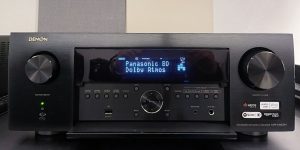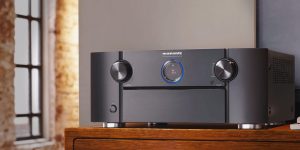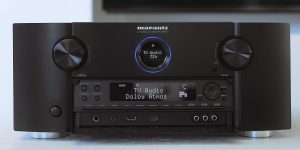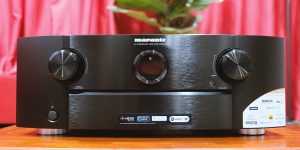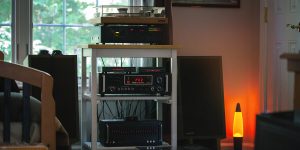If you decide to upgrade your home theatre, there’s nothing better than a set of surround speakers driven by a high-quality, properly tuned AV receiver. Many big companies specialize in producing AVR, including Yamaha. Therefore, I have prepared a review of the best Yamaha AV receivers so you can get acquainted with their products and choose the most appropriate option.
Yamaha has lots of fans worldwide and has been making them happy with the quality and sound of its home theater receivers for the past several decades. Even in its most budget models, it uses discrete amplifiers. And this is an essential benefit because they are very reliable and thus guarantee long-term use of the product.
I recommend that you take time to read this review till the end because I have selected different versions: budget, premium, and just good models. So I will give you a choice depending on your goals and financial capabilities. And here we go, starting with the best Yamaha receiver.
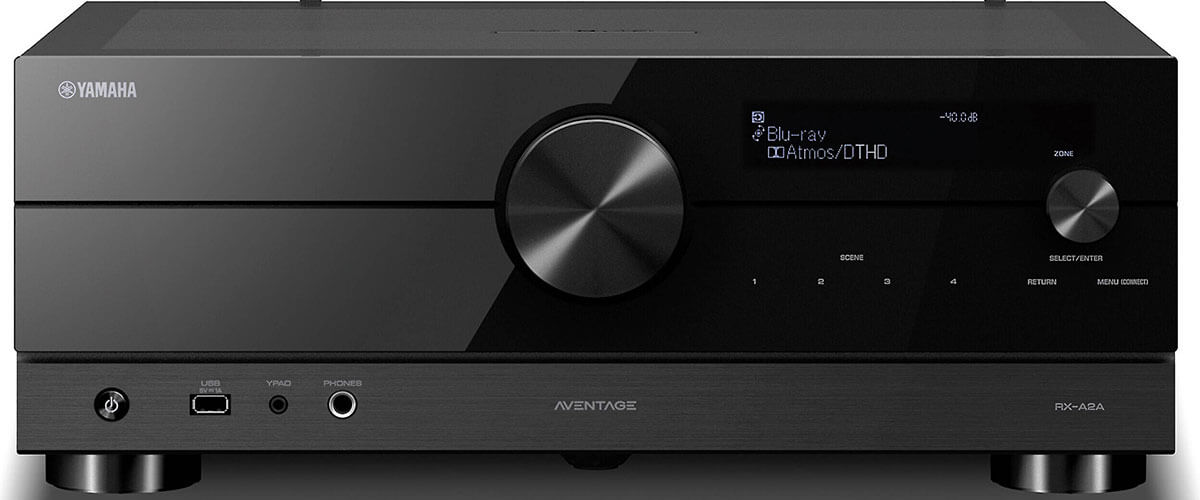
Yamaha AV receivers comparison table
| Name | Channels | Power output | HDMI in/out | Bluetooth/Wi-Fi | Review |
|---|---|---|---|---|---|
| Yamaha RX-A2A best overall | 7.2 | 100W/8 Ohm | 7/1 | yes/yes | Review |
| Yamaha RX-V385 budget | 5.1 | 70W/8 Ohm, 100W/6 Ohm | 4/1 | yes/no | Review |
| Yamaha RX-V6A also a great choice | 7.2 | 100W/8 Ohm | 7/1 | yes/yes | Review |
| Yamaha RX-A8A premium choice | 11.2 | 150W/8 Ohm | 7/3 | yes/yes | Review |
Best Yamaha AV receiver reviews
Yamaha RX-A2A – best overall

Meet a 7.2 channel Aventage series receiver with support for Dolby Atmos, DTS: X, Dolby Atmos Height Virtualization, and CINEMA DSP 3D technology. Output power (20-20,000Hz) is 100 watts per channel (8 ohms) at 0.06% THD when 2 channels are connected.
The Yamaha RX-A2A has 7 HDMI inputs (version 2.1) and one output, which supports a 4K Ultra HD signal as well as an 8K signal on three of the seven inputs. It also has analog and digital inputs, Wi-Fi, Bluetooth, USB, and Phono input. AirPlay 2 technology can be used to connect iOS devices directly. Here you also have an opportunity to connect via bi-amping. What’s more, the RX-A2A has secure screw terminals for speaker connection, conveniently located in the middle of the back panel. I think you would agree that the set of ports and features is quite extensive.
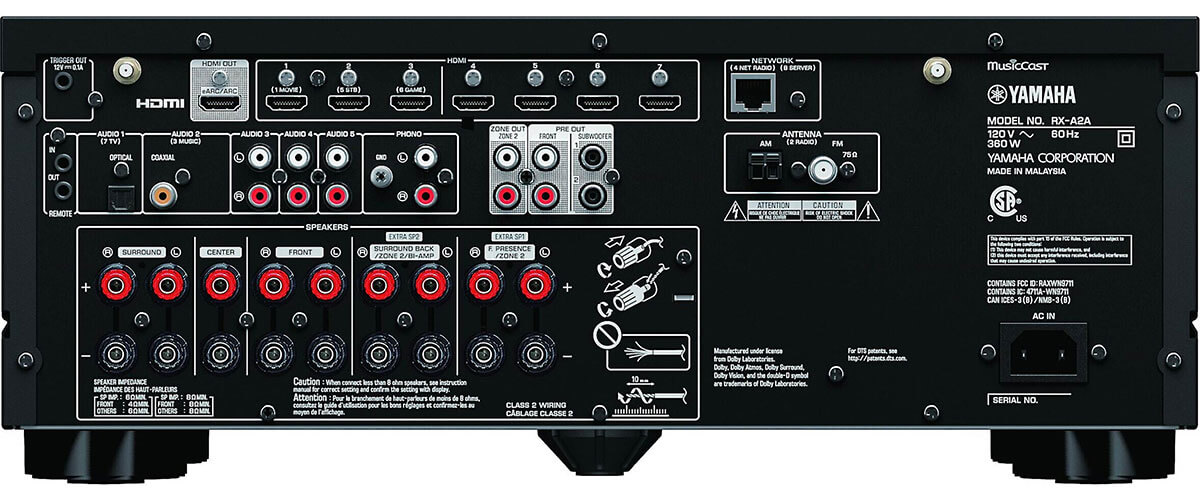
This model is equipped with the MusicCast multi-room audio system, which allows you to connect compatible wireless speakers and use popular online resources to listen to music. There are voice controls (Alexa, Google Assistant, and Siri) that also add to the convenience of use.
YPAO (Yamaha Parametric Room Acoustic Optimizer) technology is present here to conveniently adjust multi-channel sound, considering the listening room and acoustics. Content playback is supported in lossless and high-resolution formats.
I didn’t have any problems with the Yamaha RX-A2A setup; in case you have any, you can always use the AV Setup Guide. As for working with this receiver, everything is intuitive and easy to understand. But, of course, if this is the first time you see an AVR, I recommend reading the manual instead of relying on your intuition.

The Yamaha RX-A2A is quite close to the RX-V6A in terms of performance and capabilities but is slightly inferior due to the lack of special anti-resonance technology (A.R.T.). It absorbs vibrations from the power transformer, transistors, and radiators, and the speakers, which contributes to more dynamic and accurate sound reproduction.
In a nutshell, I can say that this model is the best Yamaha AV receiver in my review. Why? Because you get a high-quality receiver with premium product features for a reasonable price.
Key specs
- Channels: 7.2.
- Power output: 100W/8 Ohm.
- HDMI inputs/outputs: 7/1.
- Video functions: 8K/60Hz, 4K/120Hz, 4K/60Hz.
- Bluetooth/Wi-Fi: yes/yes.
- Streaming services: Pandora, Spotify, Napster, SiriusXM, TIDAL, Deezer, Qobuz, Amazon Music.
- Supports: HDMI eARC, HDMI Upscaling up to 4k, Dolby Vision, HDR 10+.
- Surround sound: Dolby TrueHD, Dolby Digital Plus, DTS-HD Master Audio, Dolby Surround, DTS:X, Cinema DSP.
Pros
- Dolby Atmos/DTS: X/Dolby Atmos Height Virtualization/CINEMA DSP 3D support.
- YPAO auto-calibration technology.
- Voice control.
- MusicCast multi-room audio system.
Cons
- 1 HDMI output.
Yamaha RX-V385 – budget
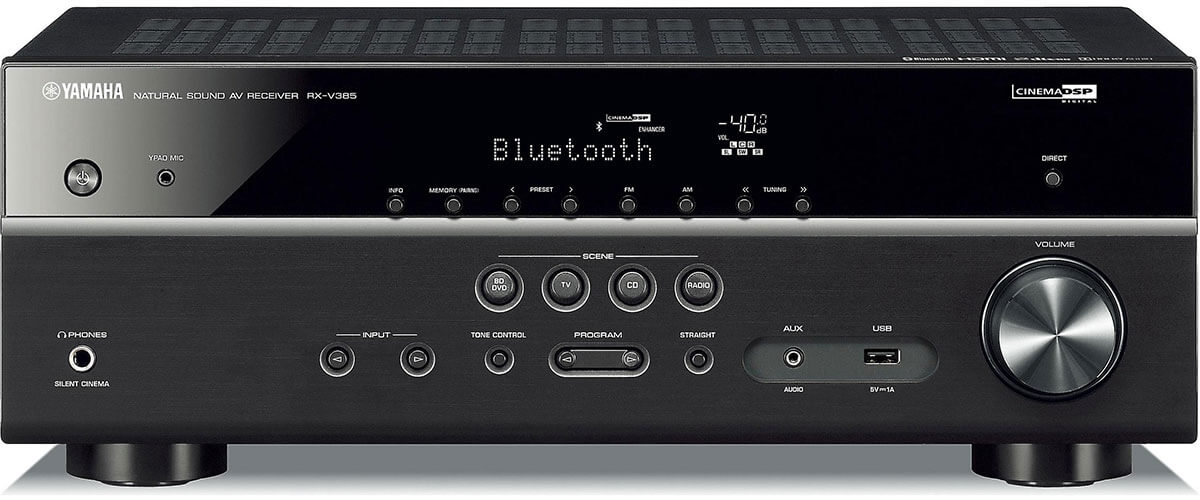
Not everyone can afford to buy a premium Yamaha home theater receiver. So, what if you don’t need the full range of extra features and your budget is limited? The good news is that you can buy Yamaha RX-V385, which fits this concept perfectly. So, let’s dig a little deeper and discover its pros and cons.
The design, size, and appearance of the control buttons in the RX-V385 have not changed from previous generations of Yamaha RX-series receivers. However, I think it is not very good that the bottom part of the front panel is made of plastic because the device heats up during the working process. This part is made of metal in more expensive models, which is definitely a better solution.
However, there is also a nice moment. Despite its affordability, this receiver’s terminals for connecting speakers are fully screwed. For example, its predecessor, RX-V383, had screw terminals only for the front pair connection. When installing, remember that the heat exhaust vents are on the top and the left side.

The Yamaha RX-V385 is a 5.1-channel AV receiver with a fully discrete configuration and DAC: Burr-Brown 384kHz/32-bit DAC x 3. Output power (20-20,000Hz) is 70 watts per channel (6 ohms) at 0.9% THD when 2 channels are connected.
The receiver supports all modern video formats: 4K, HDR10, Dolby Vision, HLG and BT.2020 color space. While using it, I did not have a single failure with the image output (including high resolution) and multi-channel audio. The main thing in the system is to use quality HDMI cables.
As for the sound, everything is quite decent: Yamaha’s exclusive CINEMA DSP technology supports HD Audio (Dolby® TrueHD, DTS-HD Master Audio™, etc.), and there is a YPAO sound optimization system and Bi-amp connection.
When it comes to connectors, Yamaha RX-V385 has four HDMI inputs, one HDMI output (eARC) with HDCP 2.3 support, coaxial audio input x 2, stereo line-level audio input x 2, optical audio input, composite video input x 3, composite video output, 6.3 mm jack headphone output, subwoofer output, USB port, Bluetooth with Music Enhancer.
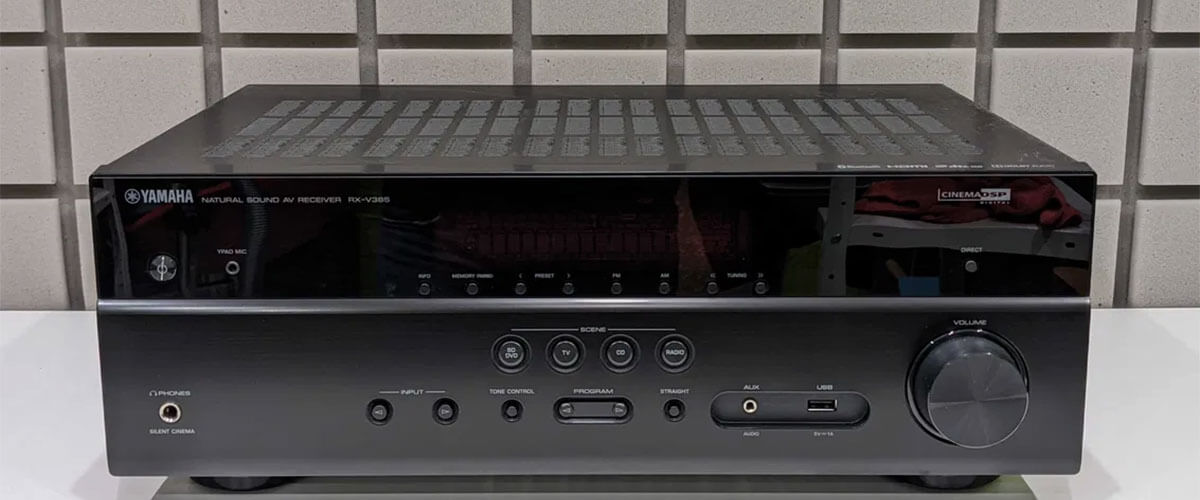
Leaving aside the lack of premium features, the RX-V385 is not inferior to the YAMAHA RX-A2A in basic features, but the price tag is lower.
All in all, I would say that this model is a great budget Yamaha AV receiver and a good choice for the price. The Yamaha RX-V385 will suit people who don’t have high demands on their system, who just need a good “workhorse.”
Key specs
- Channels: 5.1.
- Power output: 70W/8 Ohm , 100W/8 Ohm.
- HDMI inputs/outputs: 4/1.
- Video functions: 4K/60Hz.
- Bluetooth/Wi-Fi: yes/no.
- Supports: HDMI eARC, HDMI Upscaling up to 4k, Dolby Vision, HDR 10+.
- Surround sound: Dolby TrueHD, Dolby Digital Plus, DTS-HD Master Audio.
Pros
- 4 HDMI inputs, 1 HDMI output (eARC) with HDCP 2.3 support.
- YPAO auto-calibration technology.
- ECO-mode to reduce power consumption.
Cons
- No Dolby Atmos/DTS:X.
- No Wi-Fi.
- No multi-room zone.
- FLAC is not supported.
Yamaha RX-V6A – also a great choice

The Yamaha RX-V6A is a great option if you’re looking for a good visual-oriented model. The RX series is intended more for movies, concerts, and video clips than for listening to high-quality audio formats. That is why I bought this receiver to watch movies in 5.1 format.
As for the design, everything is standard here- the classic black color, but a high-resolution LCD complements RX-V6A. Note that the device itself is pretty big, so make sure you have enough space for its comfortable installation.

This receiver is ready to handle 8K content (4K at up to 120Hz and 8K at 60Hz), and the RX-V6A supports 8K on three of the seven HDMI inputs. Output power (20-20,000Hz) is 100 watts per channel (8 ohms) at 0.06% THD when 2 channels are connected. 384kHz/32-bit DAC. As it befits a high-end RX series model, this receiver supports all the latest surround sound formats. And, of course, the gamers are also not forgotten because the receiver includes the ALLM, VRR, QMS, and QFT functions.
The RX-V6A provides MusicCast’s proprietary functionality with Wi-Fi, AirPlay 2, and Spotify Connect. It supports music streaming services, multi-room, and voice control via Alexa, Google, and Siri. In addition, the Yamaha MusicCast 20 and MusicCast 50 wireless speakers can operate as part of a home theater.
The RX-V6A is versatile enough to connect additional equipment and is fully equipped. 7 HDMI inputs, 1 HDMI output (ARC), 4 analog audio inputs, USB (front panel) input, headphone jack, Zone2 audio output and Phono. I am happy with Bluetooth as I often use it to listen to music from my phone.
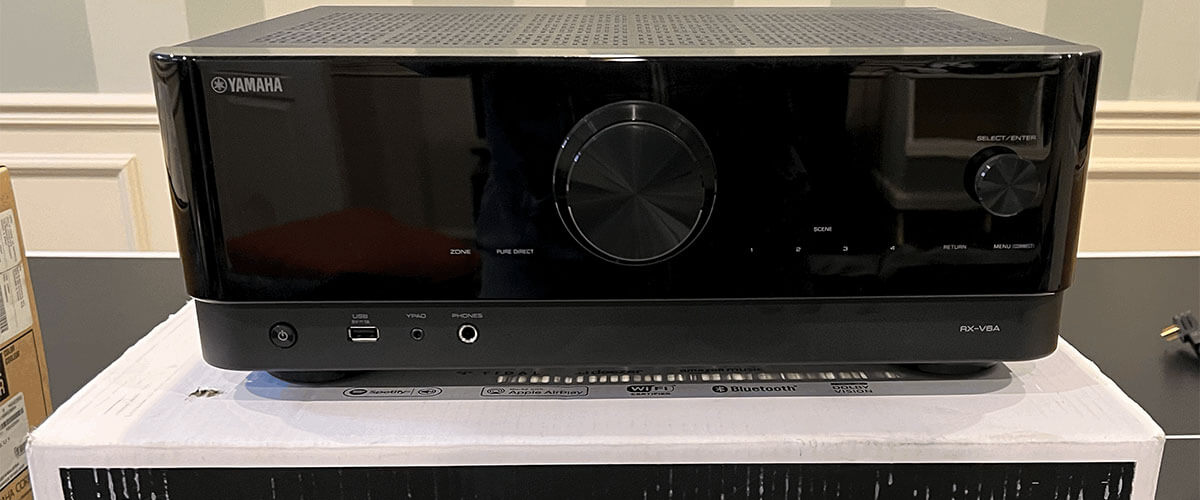
Setting up the Yamaha AVR is quite simple. Just follow the instructions on the mobile app (or rely on your own experience if you have one). I don’t use the remote control – the mobile app entirely replaces it. Personally, I had a little trouble only with the YPAO settings and sound settings.
This multi-zone receiver has all the features and characteristics to be considered one of the leaders in the niche. So check it out carefully and see if it is your perfect choice.
Key specs
- Channels: 7.2.
- Power output: 100W/8 Ohm.
- HDMI inputs/outputs: 7/1.
- Video functions: 8K/60Hz, 4K/120Hz, 4K/60Hz.
- Bluetooth/Wi-Fi: yes/yes.
- Streaming services: Pandora, Spotify, Napster, SiriusXM, TIDAL, Deezer, Qobuz, Amazon Music.
- Supports: HDMI eARC, HDMI Upscaling up to 4k, HDMI CEC, HDCP2.3, HDR10+, Dolby Vision.
- Surround sound: Dolby TrueHD, Dolby Digital Plus, DTS:X, DTS-HD Master Audio.
Pros
- Works with 8K content.
- Supports all modern surround sound formats.
- Multi-room MusicCast.
- YPAO auto-calibration technology.
- 7 HDMI inputs.
Cons
- HDMI ports are 2.1 version, but bandwidth is only 24 Gbps.
- Speakers other than the front stereo pair must be at least 6 ohms impedance.
- The occasional problem with HDMI (ARC) is that the sound transmission from the TV to the receiver does not always work.
Yamaha RX-A8A – premium choice
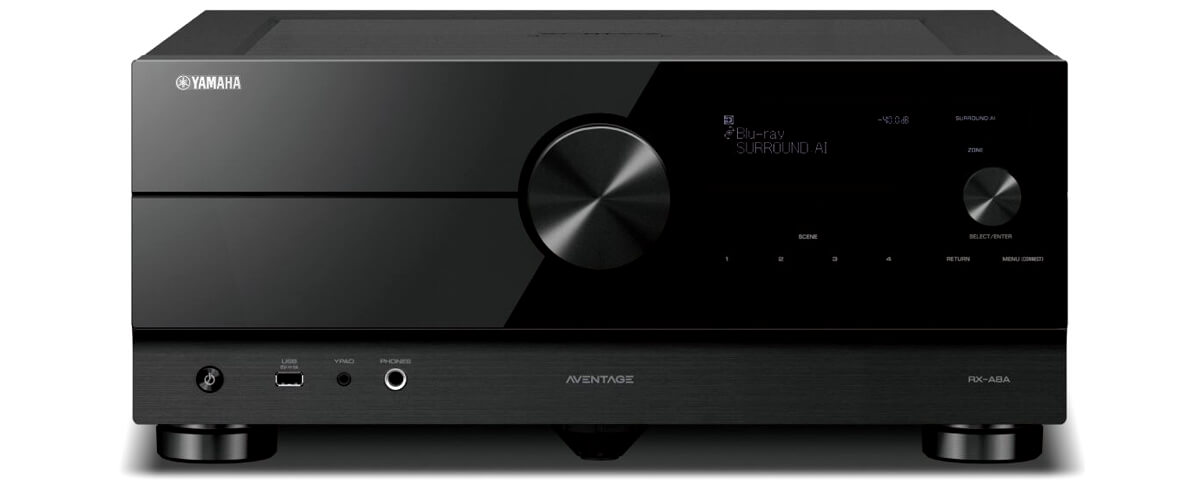
Well, here we are with a receiver that has everything. Yes, I was not mistaken. Today, this “genie” can offer its owners everything they want (and maybe a little more).
As you may have already realized, this model is the flagship of the Aventage line and was released in 2021. According to the manufacturer, special attention has been paid to efficient signal transmission and reduced transient impedance. All electronics are mounted on 4-layer boards, which indeed allowed to achieve almost perfect dilution. The voltage and current gain stages are powered from separate sources with their own power transformers. In addition, specialized storage capacitors with increased capacitance are installed.
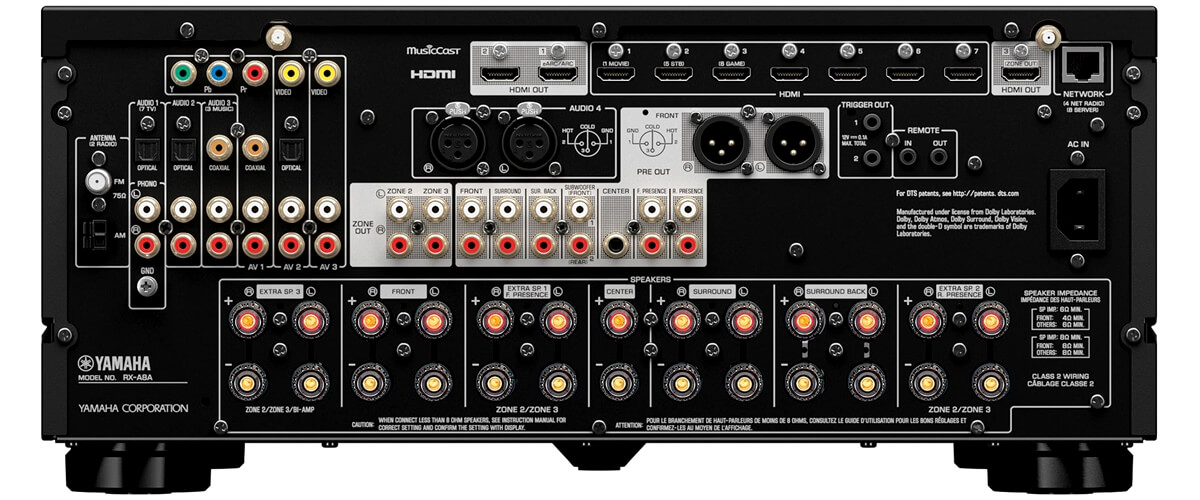
A few more words about the “stuffing”, as it deserves it. After all, the internal components form the sound quality (in fact, they create it). RX-A8A uses the Qualcomm QCS407 chipset, which is responsible for sound quality and supports Dolby Atmos and DTS:X. Also, the manufacturer used a 32-bit DAC ESS SABRE PRO Premier ES9026PRO in this model. I should also note the presence of ESS Hyper Stream technology with 32-bit architecture to compensate for common harmonic distortions (to reduce the noise level at maximum volume to a minimum).
The Yamaha RX-A8A also stays true to its tradition in design. The volume control is in the middle, the display is shifted to the right, and the cabinet itself has five legs. Everything is simple, convenient, and ergonomic. But this is not the most interesting thing, so let’s move on.
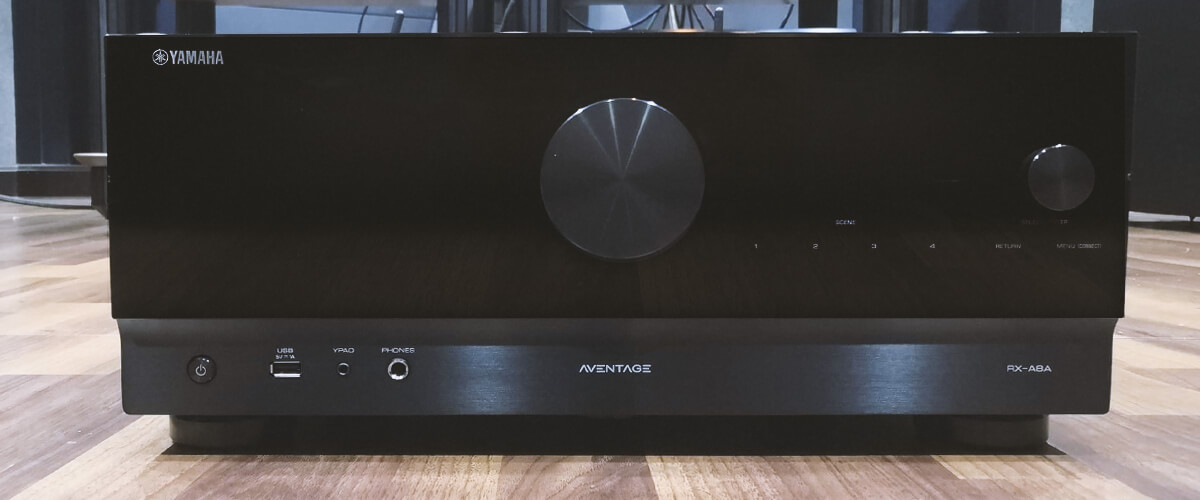
This 11.2-channel AV receiver is equipped with almost every interface and technical feature currently available on the market. It would take a very long time to list them all. Special mention should be made of the presence of Dolby Atmos with Dolby Atmos Height Virtualization, DTS:X with CINEMA DSP HD3, and AURO-3D. 3 of the 7 HDMI 2.1 inputs are for 4K/120Hz or 8K/60Hz playback, and it also has ALLM, VRR, QMS, and QFT. Of course, it supports all common HDR standards (Dolby Vision, HDR10, HLG, HDR10+).
It is also worth noting that the Yamaha RX-A8A is equipped with a MusicCast system. In addition, it supports AirPlay 2, many streaming services, voice control, and multi-zone playback (2/3/4) are available. As I said at the beginning of my review, this is a real “multimedia Genie”.
Buying the Yamaha RX-A8A is like finding Aladdin’s magic lamp. You get a modern, high-tech genie that will fulfill all your audio and video whims. Just remember that this magic lamp is expensive.
Key specs
- Channels: 11.2.
- Power output: 150W/8 Ohm.
- HDMI inputs/outputs: 7/3.
- Video functions: 8K/60Hz, 4K/60Hz, 4K/120Hz, upscaling to 8K.
- Bluetooth/Wi-Fi: yes/yes.
- Streaming services: AirPlay 2, Spotify, TuneIn, Deezer, Tidal, Netflix, Amazon Prime.
- Supports: HDMI ARC, HDMI eARC, HDMI CEC, HDCP2.3, HDR10+, Dolby Vision.
- Surround sound: DTS HD Master, DTS:X, DTS Virtual:X, Dolby Atmos, Dolby TrueHD, Dolby Digital Plus, Dolby Surround, Surround:AI, Cinema DSP, YPAO, Auro 3D.
Pros
- 11 channels of Class AB power.
- Great sound when watching movies.
- Great sounding music.
- Rich connectivity and versatility.
- A large number of additional functions.
- Expensive, high-quality, and high-performance internal components.
Cons
- I did not find any significant flaws during the testing.
Yamaha RX-A6A
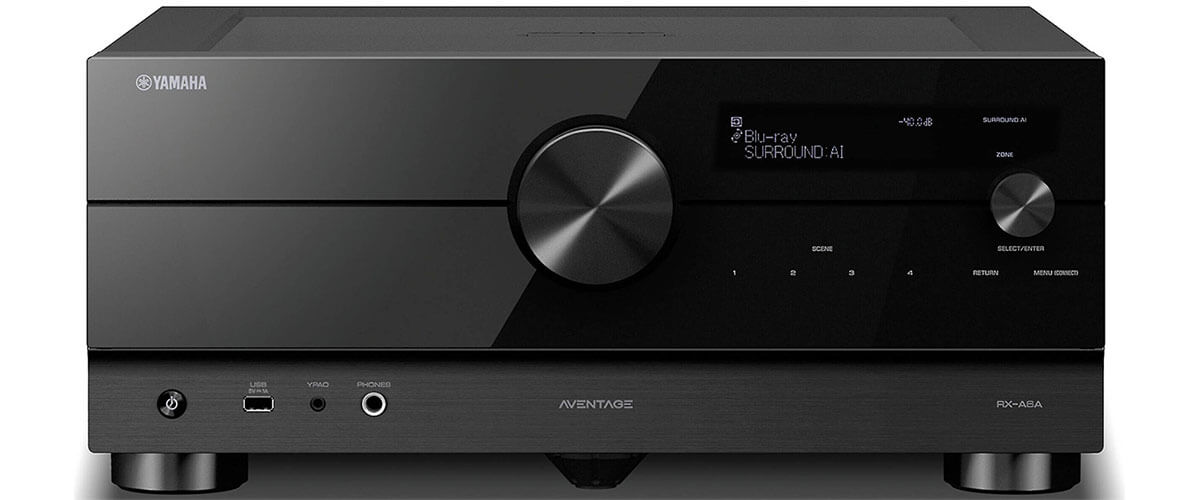
Let’s move on to another top AV receiver from Yamaha in my review. The Yamaha RX-A6A is the 9.2-channel premium model in the AVENTAGE series. This receiver supports 4K at up to 120 Hz and 8K at 60 Hz. Output power (20-20,000 Hz) is 150 watts per channel (8 ohms) at 0.06% THD when 2 channels are connected. The RX-A6A is the most powerful receiver in my review. The 384 kHz/32-bit ESS Hyperstream DAC ES9026PRO + ES9007S provides high-quality audio conversion.
As befits a flagship model, the RX-A6A supports Dolby Atmos, DTS:X, CINEMA DSP 3D, and Dolby Atmos Height Virtualization. There is also support for gamer features (ALLM, VRR, QMS, QFT). The MusicCast multi-room audio system allows you to play your favorite music throughout your home. And AirPlay 2 provides you an opportunity to stream music from Apple Music and other services to multiple MusicCast devices in different rooms.

Separately, I want to focus on sound quality. In RX-A6A, 3 unique features significantly affect the sound quality. First, SURROUND:AI technology that, using AI, analyzes the configuration of sound sources in the system and optimizes the surround sound of individual sound elements such as background music, dialogues, and various sound effects. Second, the channel-oriented sound system AURO-3D will allow listeners to hear and feel all the most exciting moments of the video sequence. Finally, the YPAO sound optimization system analyzes the acoustic configuration of the entire system and then selects the optimal sound parameters.
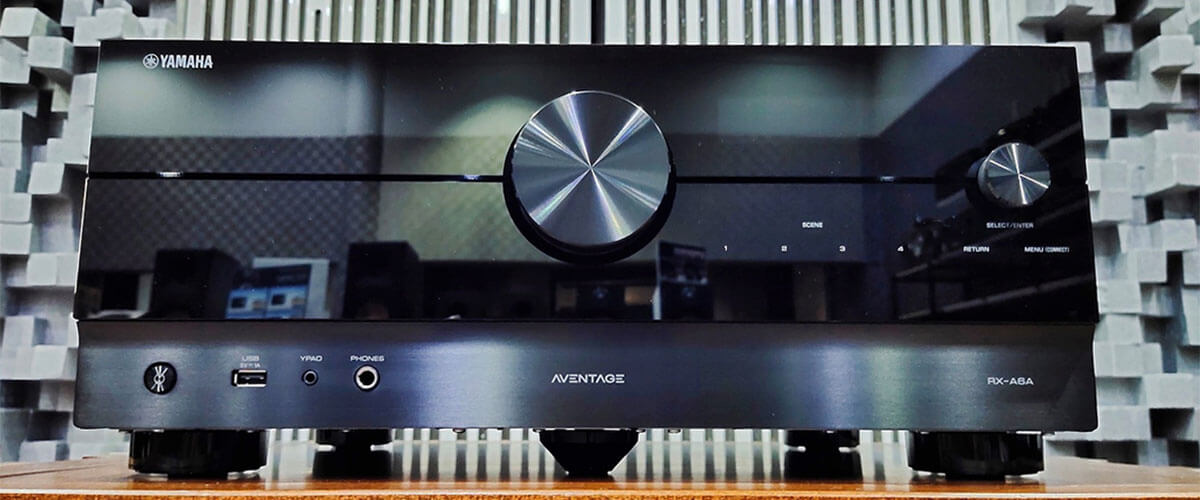
As for ports, the manufacturers have done their best: 7 HDMI inputs, 3 HDMI outputs (eARC, HDCP 2.3), USB, Bluetooth, Phono, and the rest of the standard interfaces. In addition, it supports music streaming services, multi-room, and voice control via Alexa, Google, and Siri.
There is no point in enumerating all the features and benefits of the Yamaha RX-A6A once again. It’s really good and worth its money. And it’s up to you to decide whether to buy it or not.
Key specs
- Channels: 9.2.
- Power output: 150W/8 Ohm.
- HDMI inputs/outputs: 7/3.
- Video functions: 8K/60Hz, 4K/120Hz, 4K/60Hz.
- Bluetooth/Wi-Fi: yes/yes.
- Streaming services: Pandora, Spotify, Napster, SiriusXM, TIDAL, Deezer, Qobuz, Amazon Music.
- Supports: HDMI eARC, HDMI Upscaling up to 4k, HDMI CEC, HDCP2.3, HDR10+, Dolby Vision.
- Surround sound: Dolby TrueHD, Dolby Digital Plus, DTS:X, DTS-HD Master Audio, Auro 3D.
Pros
- 9.2 channel surround sound.
- AURO-3D/SURROUND:AI/YPAO.
- Dolby Atmos/DTS:X/CINEMA DSP HD3 support.
- Multi-room MusicCast.
- 3 HDMI outputs (eARC, HDCP 2.3).
- Voice control.
Cons
- Quite heavy.
Yamaha RX-A4A
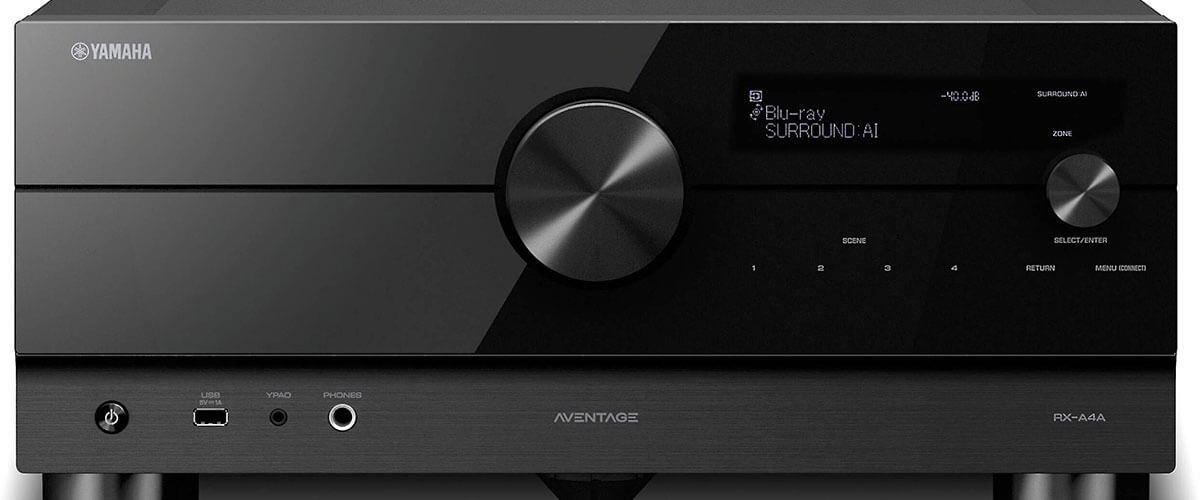
First off, the RX-A4A is a member of Yamaha’s vintage lineup. It’s a mid-range receiver with a plastic and metal chassis (which is already pretty good). This model has a 7.2-channel set where each channel supports up to 110 watts (8 ohms, 0.06% THD). In addition, the SABRE ES9007S Premier DAC significantly improves the signal-to-noise ratio and has a wide dynamic range, which positively affects sound quality.
Yamaha RX-A4A supports 4K video at 120Hz, 8K video at 60Hz, HDR10+ video, and also includes Yamaha Cinema DSP 3D.
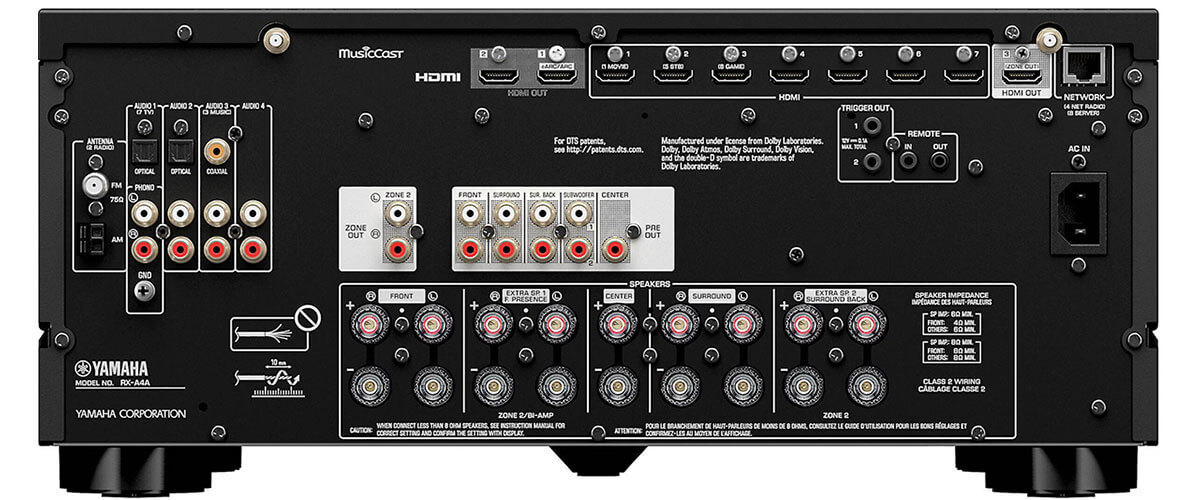
The sound systems of this model feature SURROUND: AI surround sound. Yamaha’s artificial intelligence analyzes different sound elements (dialog, background music, sound effects, etc.) and creates the optimal effect for the specific situation. Well, a big plus is that SURROUND: AI also supports playback in combination with Dolby Atmos or DTS: X.
The AVENTAGE RX-A4A has 7 x HDMI 2.1 (all at 40 gigabits per second), 3x analog stereo, front USB-A, classic Ethernet, Bluetooth, Wi-Fi, Phono (a special input designed to connect devices that play gramophone records), and a M/DAB+ antenna. This model also has 3 HDMI 2.3 (eARC), an analog 2.1 output, a 6.5mm headphone output, and 9 jacks for paired speakers. Considering the receiver’s average level, its ability to connect various devices is extensive. This is a clear advantage of RX-A4A.
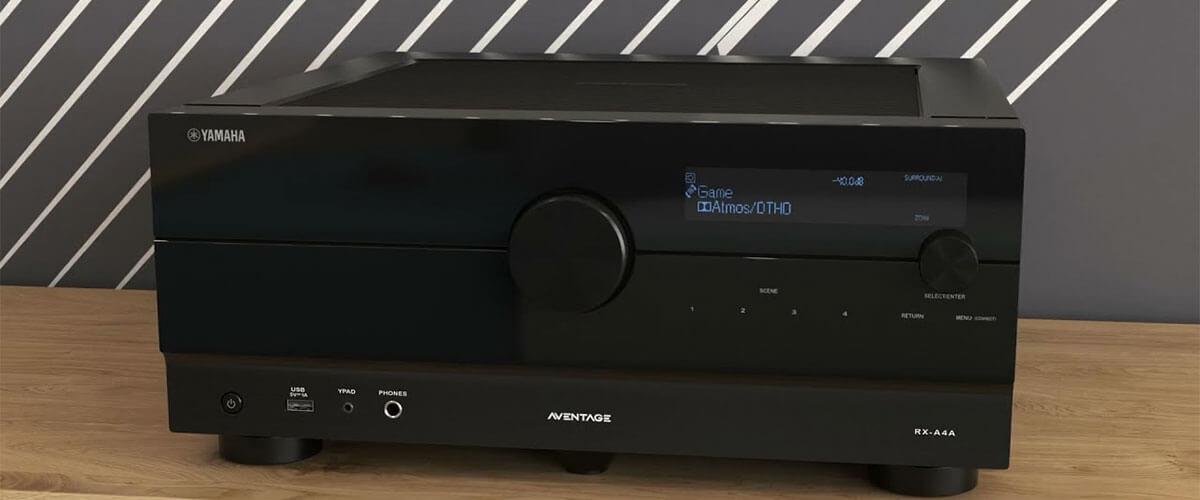
Yamaha RX-A4A features YPAO sound optimization system, AirPlay 2, multi-room audio system – MusicCast. The gamers will be pleased with the ALLM, VRR, QMS, and QFT functions. Moreover, support for Amazon Music, Spotify, Pandora, Tidal, Qobuz, and Deezer streaming services is implemented.
To summarize, I can say that Yamaha RX-A4A is certainly not a top seller, but it is not a budget option either. Therefore, it deservedly takes its place between premium class devices and entry-level. I am sure that it will definitely satisfy most of the potential customers and their inquiries!
Key specs
- Channels: 7.1.
- Power output: 110W/8 Ohm.
- HDMI inputs/outputs: 7/3.
- Video functions: 8K/60Hz, 4K/120Hz, 4K/60Hz .
- Bluetooth/Wi-Fi: yes/yes.
- Streaming services: Pandora, Spotify, Napster, SiriusXM, TIDAL, Deezer, Qobuz, Amazon Music HD.
- Supports: HDMI eARC, HDMI Upscaling up to 8K, HDMI Audio Return Channel, HDMI Up-conversion, HDR 10+, Dolby Vision.
- Surround sound: Dolby TrueHD, Dolby Digital Plus, DTS:X, DTS-HD Master Audio, Auro 3D.
Pros
- High power: 110 watts per channel.
- SURROUND: AI function.
- Cinema DSP 3D/Dolby Atmos/DTS: X/Dolby Atmos High Altitude Virtualization.
- Supports advanced voice control systems.
- Supports 8K 60Hz.
Cons
- No front HDMI.
- Requires at least 6-ohm speakers (except front speakers).
Yamaha AVR buying guide
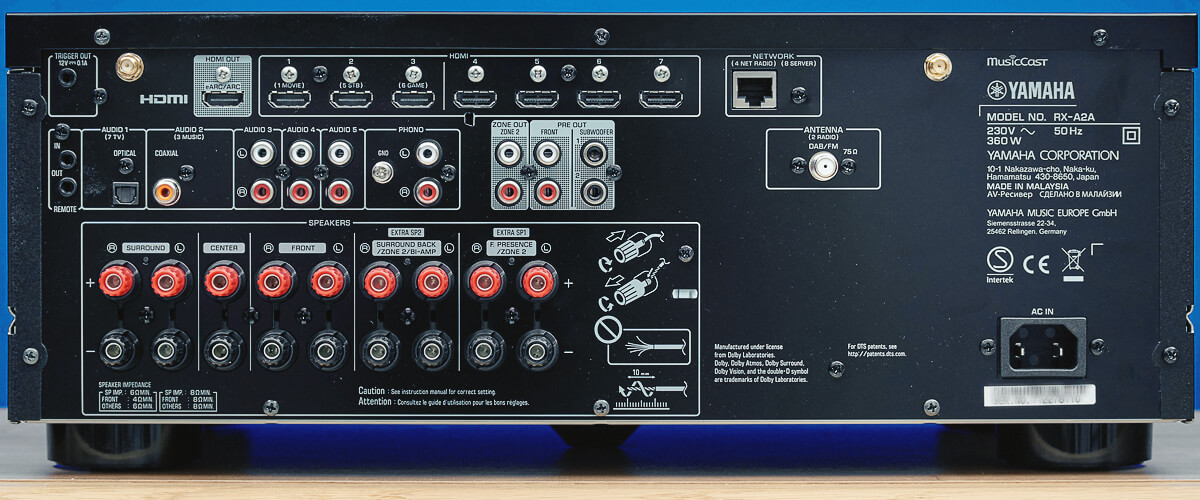
How much power per channel do I need?
It is important to understand that power is not just the volume of the sound. In this case, it is the AVR’s ability to provide your ears with surround and dynamic sound. So, a receiver with higher power will give you better sound than a receiver with less power, even at low to medium volume.
When choosing, pay attention that the receiver must be powerful enough to communicate with all the speakers attached to it and fully cover the room where you’re going to place it. The amount of power required to properly interface with each particular speaker depends on the speaker’s acoustic sensitivity (the number of decibels it produces per watt of power).
And, of course, keep in mind that the level of power required depends on the room size. The larger the room is, the more power the receiver requires for better performance. So, for example, small rooms up to 30 m2 don’t require 100+ watts; 70 or 80 watts will be enough.
Sound quality is also influenced by the THD (Non-Linear Distortion Ratio). The lower the THD is, the cleaner the sound will be. So pay attention to this parameter, too.
How many amplifier channels do I need?
Most modern receivers today have from 5 to 13 amplifier channels. If you think your system won’t be more than Dolby Digital (3 front speakers and a couple of surround speakers), then a 5-channel receiver will become your optimal solution. However, if you want advanced music features or wish to upgrade your system later, I suggest looking at models with more channels.
Required inputs or outputs
I recommend that you stick to the rule “there can’t be too many inputs or outputs. “Try to make a list of equipment and identify all the interface options you may need. If the old standard connectors (optical, coaxial) are now needed only in single variants, the HDMI ports have become the main solution, and sometimes the basic 4-5 pieces are not enough.
Video commutation and switching between multiple devices connected to the same screen through your receiver are also very important. Such devices include a laptop or home PC, a TV set-top box, satellite receiver, Blu-ray player, or game console. As you see, there can be a lot of devices, and therefore there should be a lot of ports.
You need a USB to connect external drives with content – the 2.0 version is enough, but it’s better when you have two ports. If you have a vinyl player, you will need a special input for the phono stage. But the number of outputs should not bother you unless we are talking about professional use.
Built-in Wi-Fi and streaming music services
Nowadays, there is hardly an AVR that is not equipped with wireless communication via Bluetooth or Wi-Fi. This happened due to the emergence of wireless speakers and other devices, as well as the active use of streaming services for listening to music, which has recently become very popular.
Ideally, your new receiver will already have Chromecast, Apple Airplay 2, or MusicCast built in so you can enjoy streaming music. By the way, all Yamaha receiver models have Wi-Fi and MusicCast, which supports any source, even audio, from your TV.
8K, HDCP 2.2, HDR formats support
8K technology as part of the HDMI 2.1 specification provides a maximum data rate of about 48 Gbps. This is about 2.5 times the speed of the previous generation. 4K Ultra HD has a resolution of 3840×2160 pixels per frame. 8K has twice as much on each side – 7680×4320 pixels. It turns out that one frame in 8K contains four times as many pixels as in 4K. Over the past few years, 8K technology has been actively adopted and is gradually replacing 4K receivers.
HDCP 2.2 is an advanced copyright protection technology designed to block illegal copying of video content, especially 4K content. If you try to watch a movie with HDCP 2.2 copy protection and your AV receiver is not properly licensed to receive HDCP 2.2 content, your display will go black. That is why almost all 4K TVs and receivers have at least one HDCP 2.2 input.
HDR stands for “high dynamic range.” This technology provides higher contrast of available pixels and enhances contrast along with color, resulting in a more detailed final effect with greater depth. There are 4 versions of HDR: HDR 10, HDR 10+, DV (Dolby Vision), and HLG. Although HDR 10 is the most common format currently available, many consider Dolby Vision to be the preferred format for image quality.
Surround sound formats capability
Dolby Atmos and DTS:X are two of the latest surround sound formats. The main feature of Dolby Atmos technology is the ability to obtain a surround sound picture, in which the sound motion during playback goes horizontally and from above. Today Dolby Atmos is supported by numerous modern home theater components. However, the surround sound receiver is also not uncommon, so I recommend choosing a model that supports this format (if, of course, you have the opportunity to place the speakers on top).
In 2015, the Californian company Digital Theater System (DTS) announced a new multi-channel sound format DTS:X, which quickly gained recognition and became actively used in receivers. DTS:X technology is based on processing sound objects and is designed to form a surround sound, “which moves in space, as in real life.”
The difference between DTS:X and Dolby Atmos lies in the speaker configuration requirements. While Dolby Atmos requires the addition of additional overhead speakers to a 5.1 or 7.1-channel set in order to function, DTS:X is quite sufficient as a standard set.

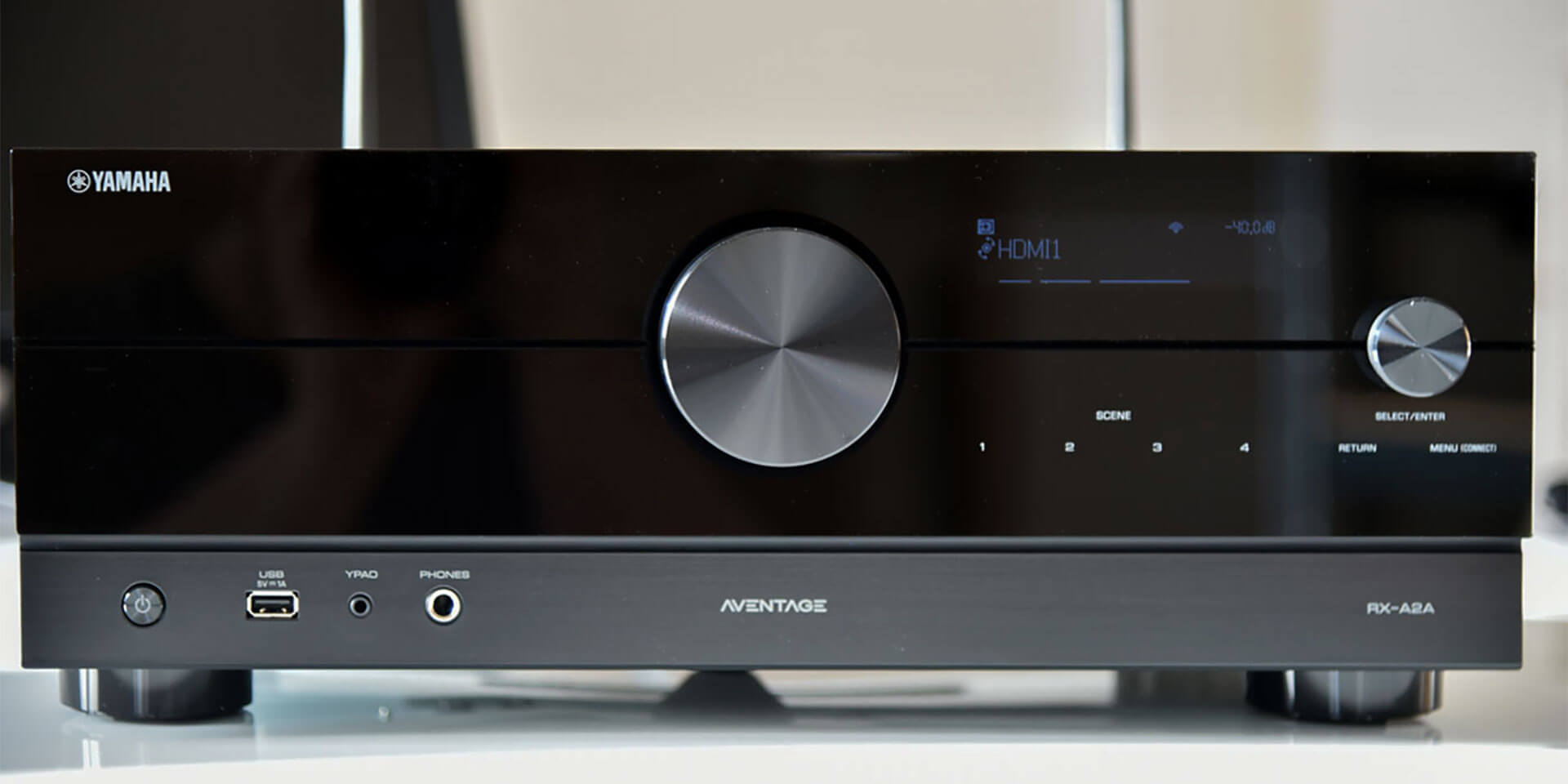


![Best 2-Channel Receiver [Expert Reviews and Buying Guide]](https://hometheaterology.com/wp-content/uploads/2023/11/best-2-channel-receiver-stereo-300x150.jpg)

